Abstract
1. The suprachiasmatic nucleus (SCN) of the hypothalamus is the primary pacemaker for circadian rhythms in mammals. The 24 h pacemaker is endogenous to the SCN and persists for multiple cycles in the suprachiasmatic brain slice. 2. While serotonin is not endogenous to the SCN, a major midbrain hypothalamic afferent pathway is serotonergic. Within this tract the dorsal raphe nucleus sends direct projections to the ventrolateral portions of the SCN. We investigated a possible regulatory role for serotonin in the mammalian circadian system by examining its effect, when applied at projection sites, on the circadian rhythm of neuronal activity in rat SCN in vitro. 3. Eight-week-old male rats from our inbred colony, housed on a 12 h light: 12 h dark schedule, were used. Hypothalamic brain slices containing the paired SCN were prepared in the day and maintained in glucose and bicarbonate-supplemented balanced salt solution for up to 53 h. 4. A 10(-11) ml drop of 10(-6) M-serotonin (5-hydroxytryptamine (5-HT) creatinine sulphate complex) in medium was applied to the ventrolateral portion of one of the SCN for 5 min on the first day in vitro. The effect of the treatment at each of seven time points across the circadian cycle was examined. The rhythm of spontaneous neuronal activity was recorded extracellularly on the second and third days in vitro. Phase shifts were determined by comparing the time-of-peak of neuronal activity in serotonin- vs. media-treated slices. 5. Application of serotonin during the subjective day induced significant advances in the phase of the electrical activity rhythm (n = 11). The most sensitive time of treatment was CT 7 (circadian time 7 is 7 h after 'lights on' in the animal colony), when a 7.0 +/- 0.1 h phase advance was observed (n = 3). This phase advance was perpetuated on day 3 in vitro without decrement. Serotonin treatment during the subjective night had no effect on the timing of the electrical activity rhythm (n = 9). 6. The specificity of the serotonin-induced phase change was assessed by treating slices in the same manner with a microdrop of serotonergic agonists, 5-carboxamidotryptamine, that targets the 5-HT1 class of receptors, or 8-hydroxy-dipropylaminotetralin (8-OH DPAT), that acts on the 5-HT1A receptor subtype.(ABSTRACT TRUNCATED AT 400 WORDS)
Full text
PDF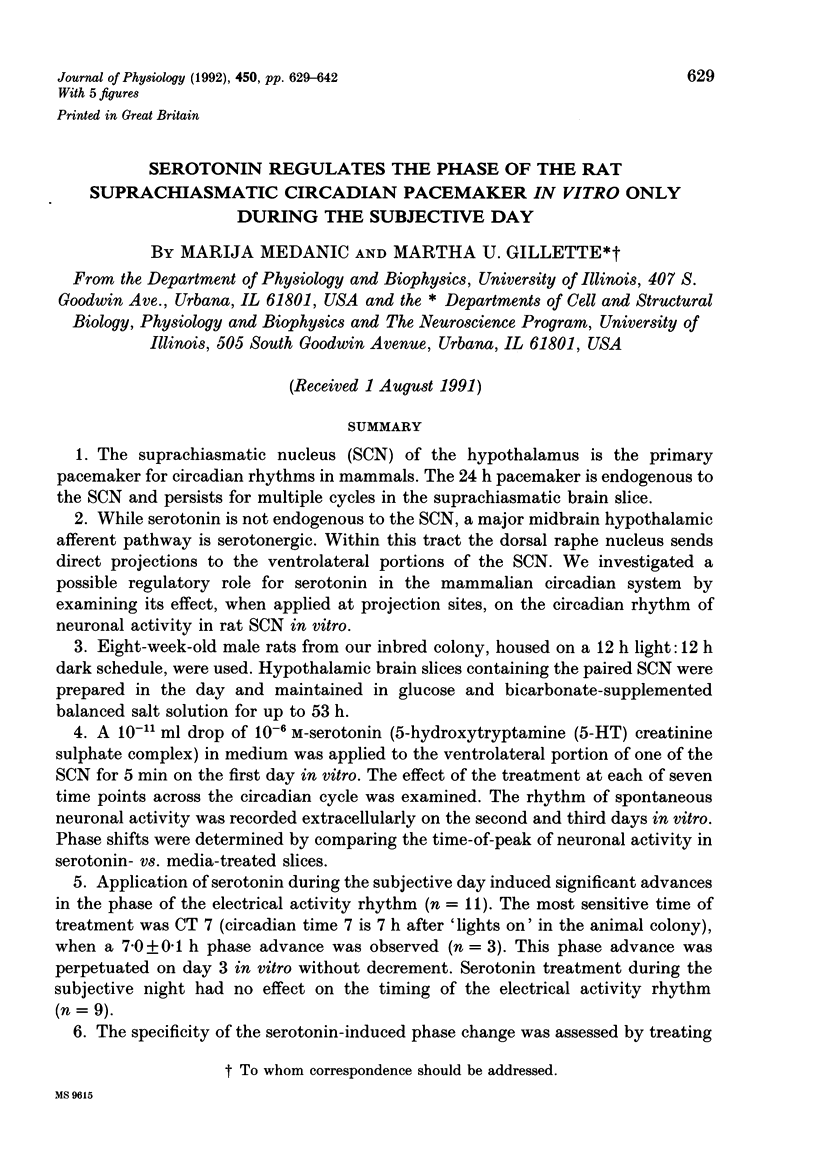
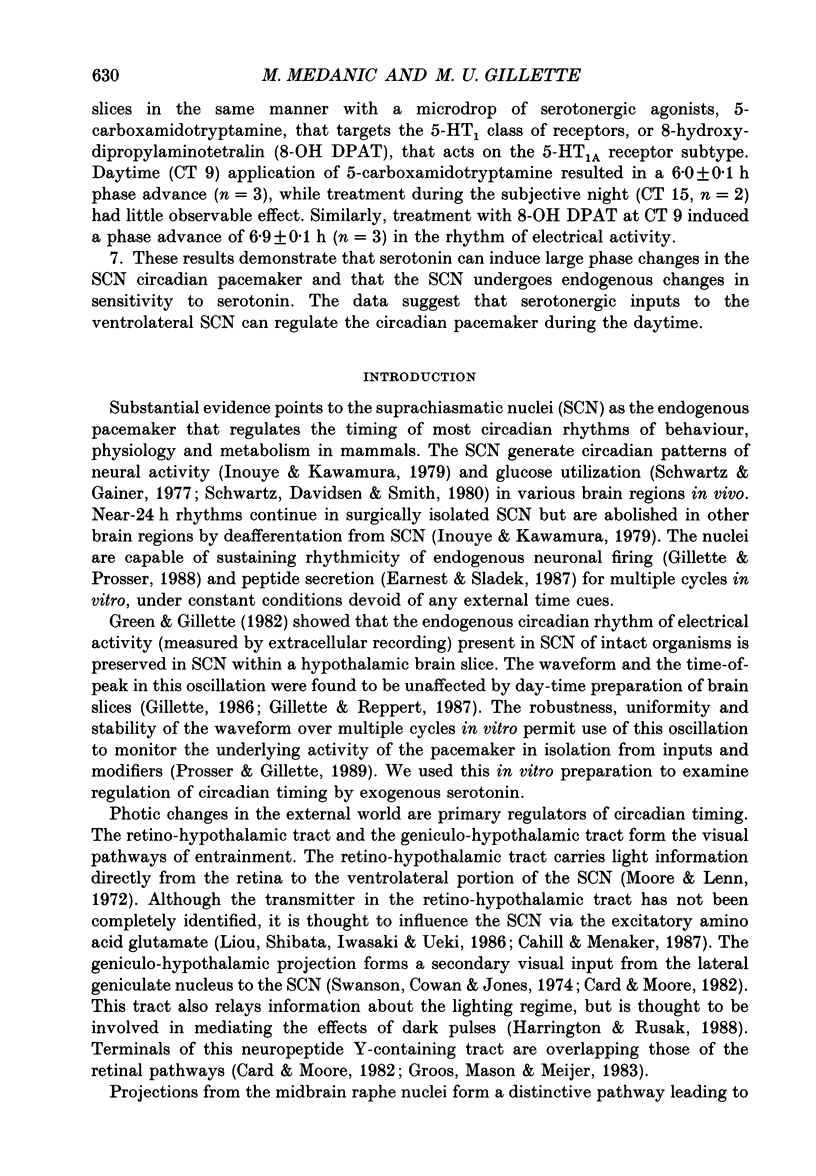
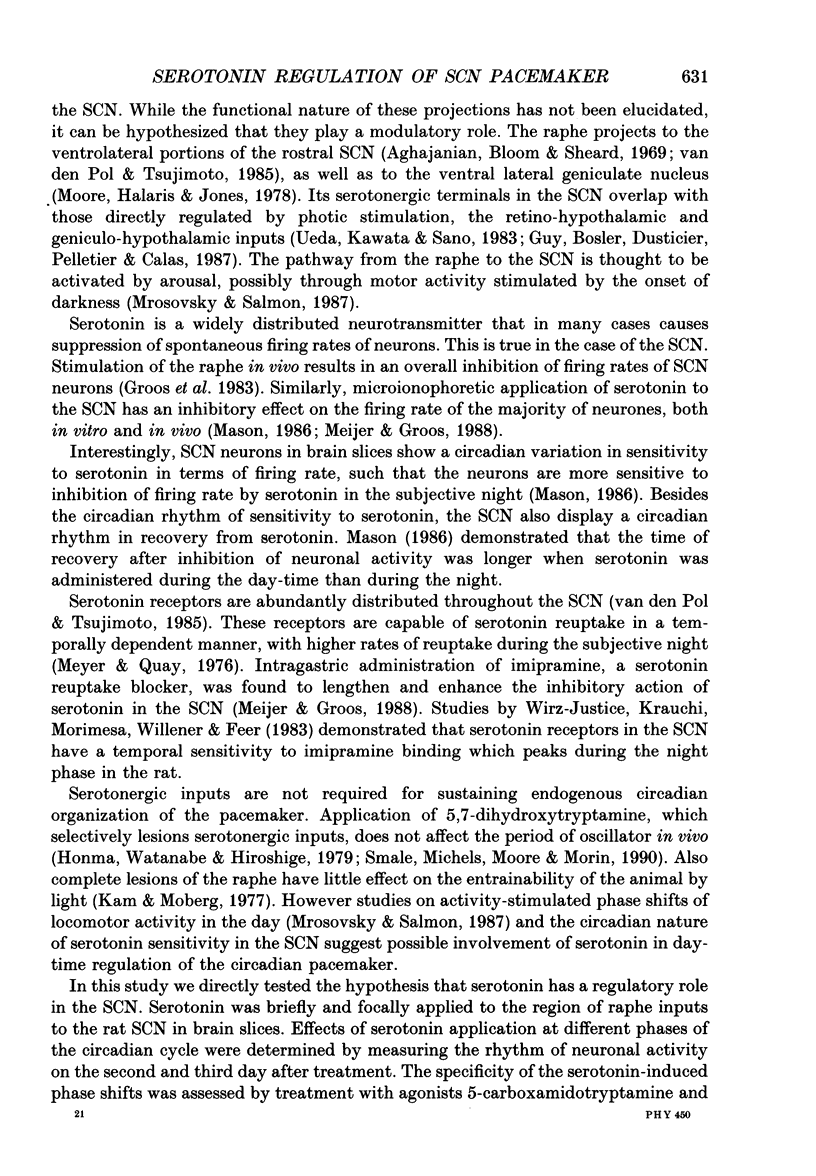
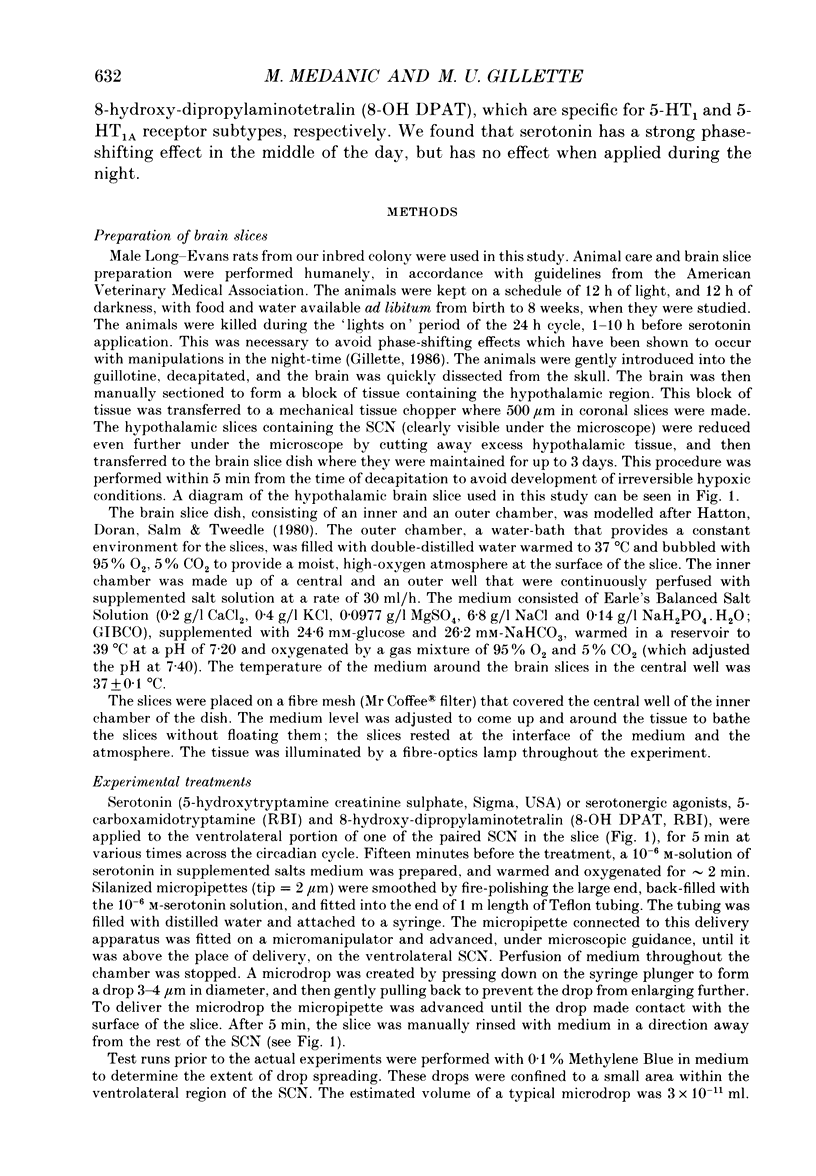
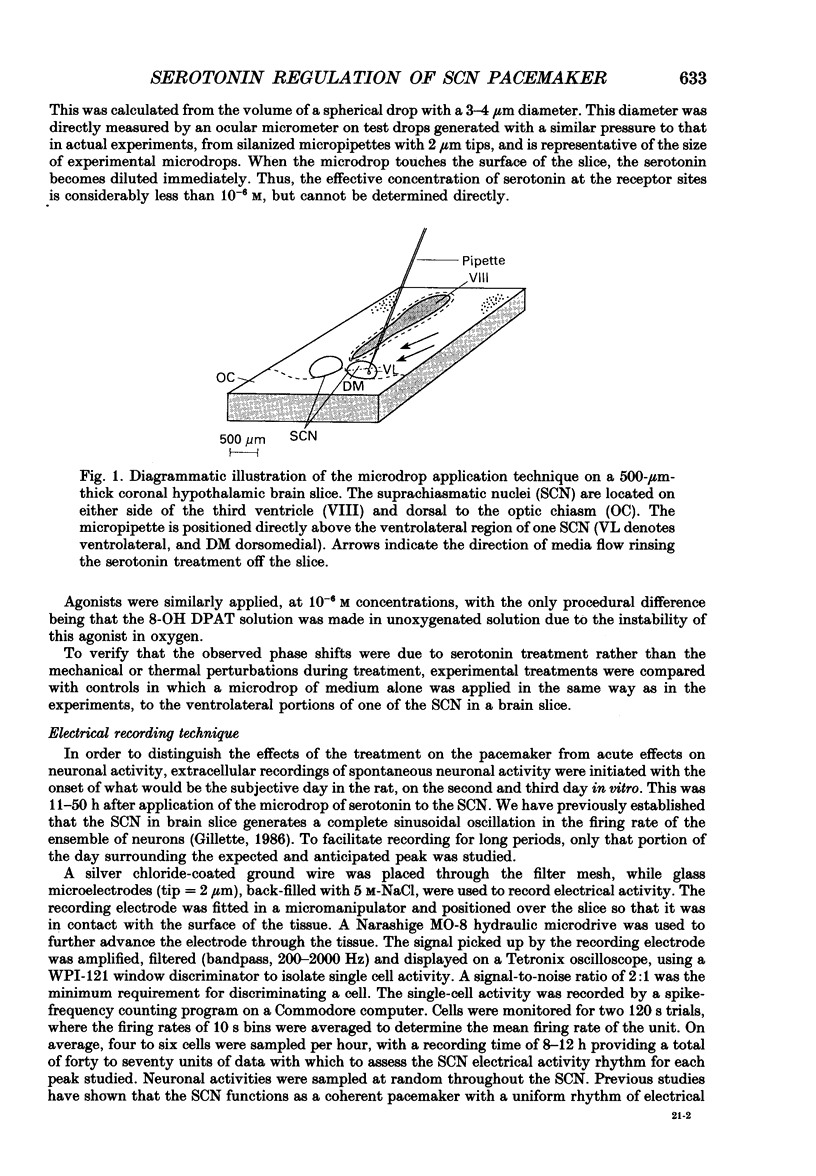
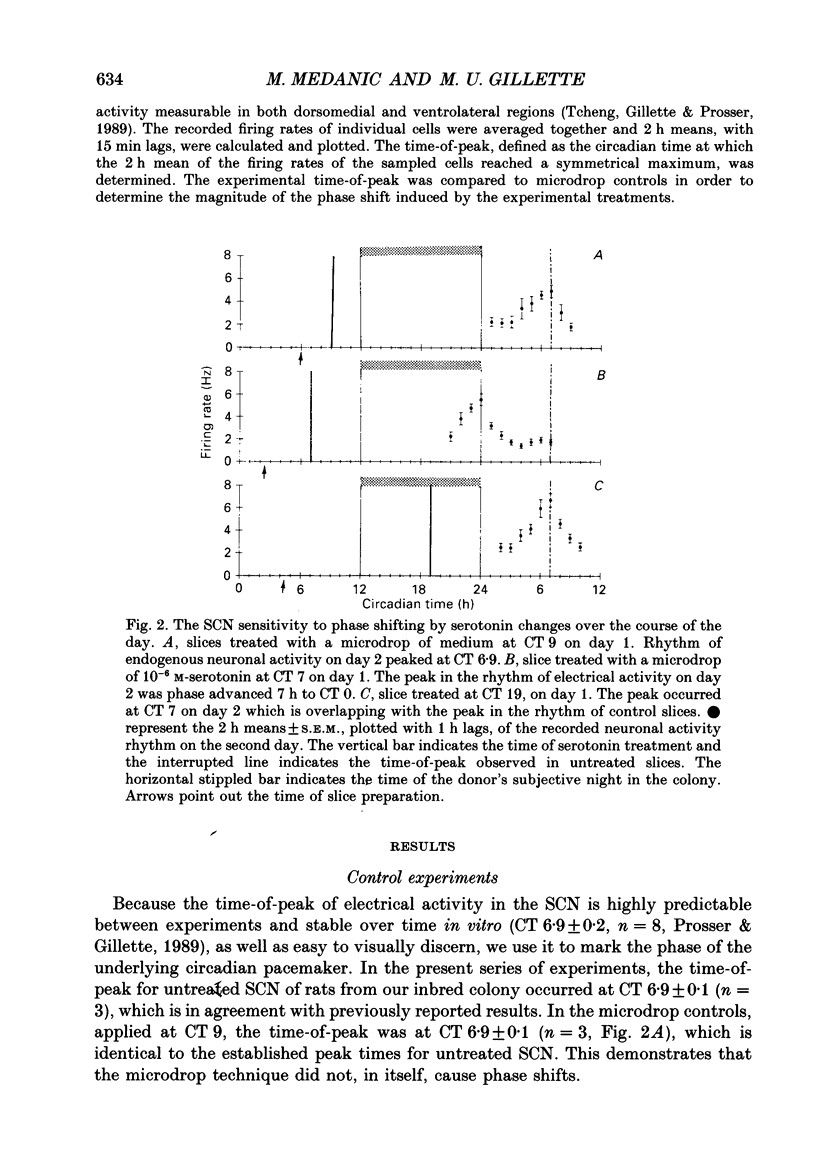

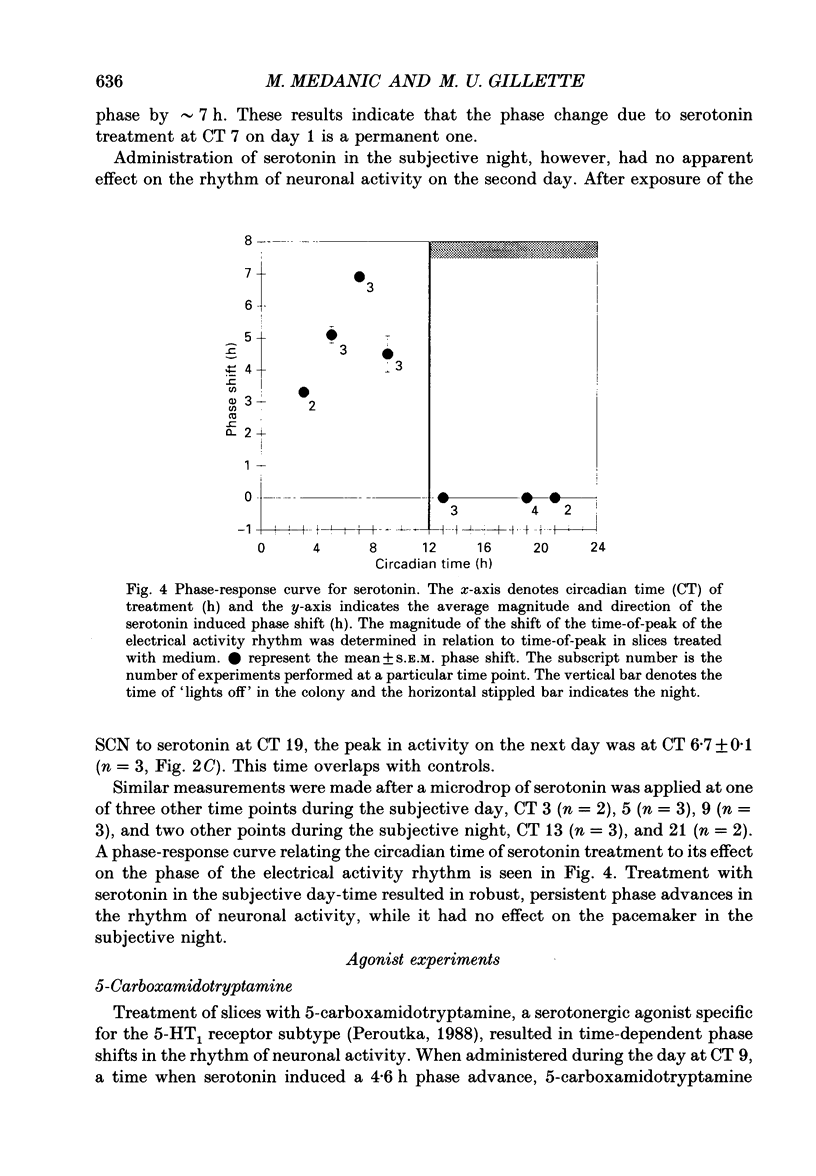
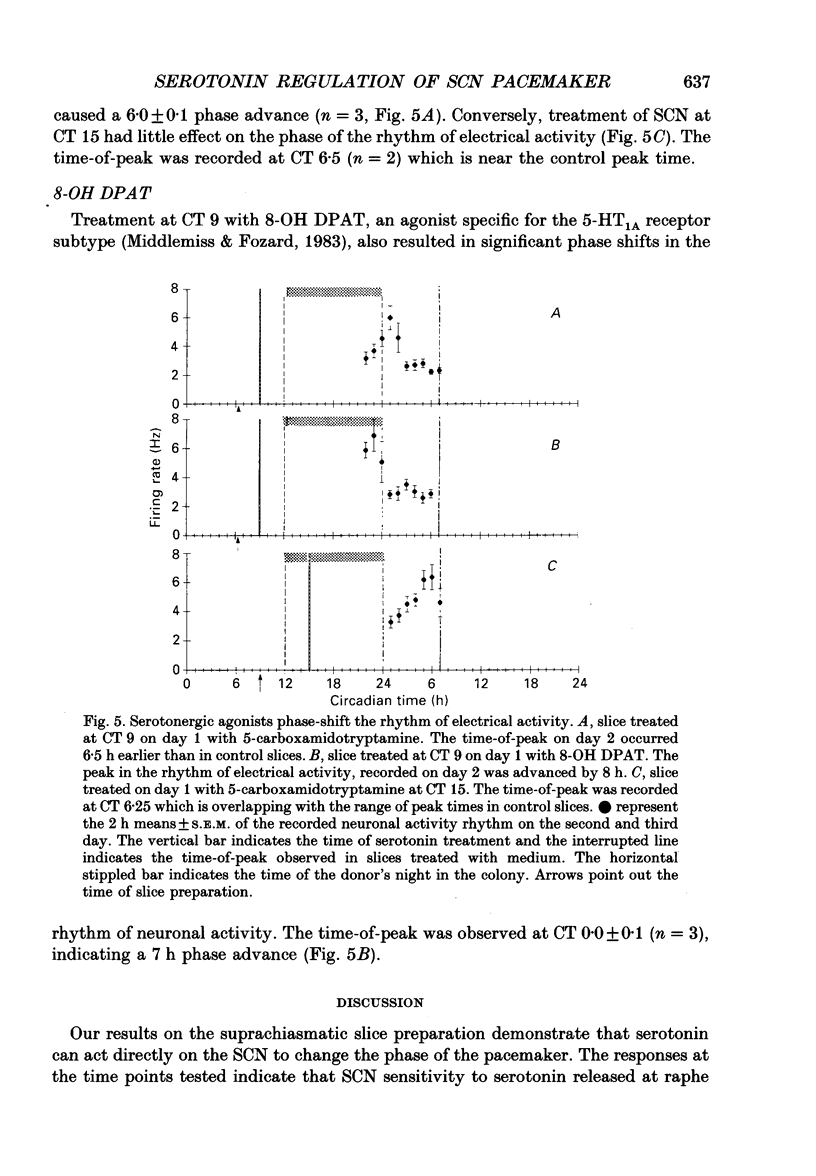
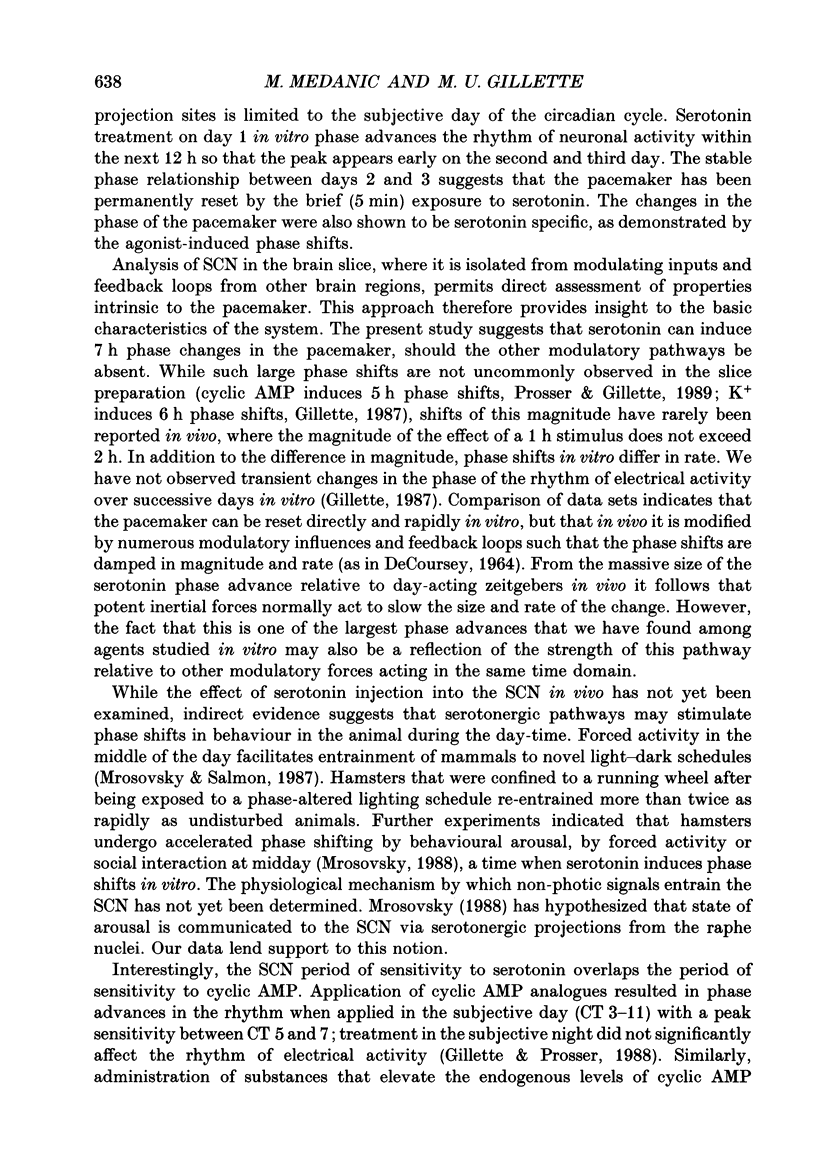
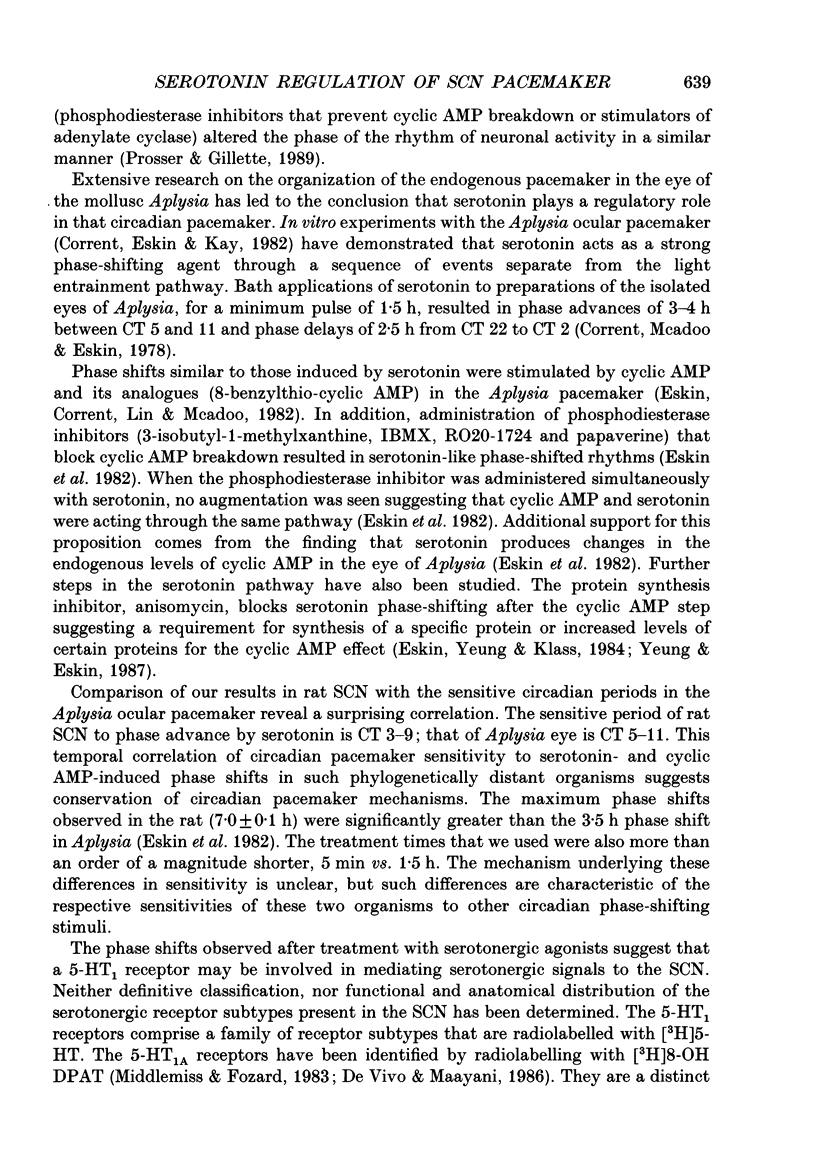
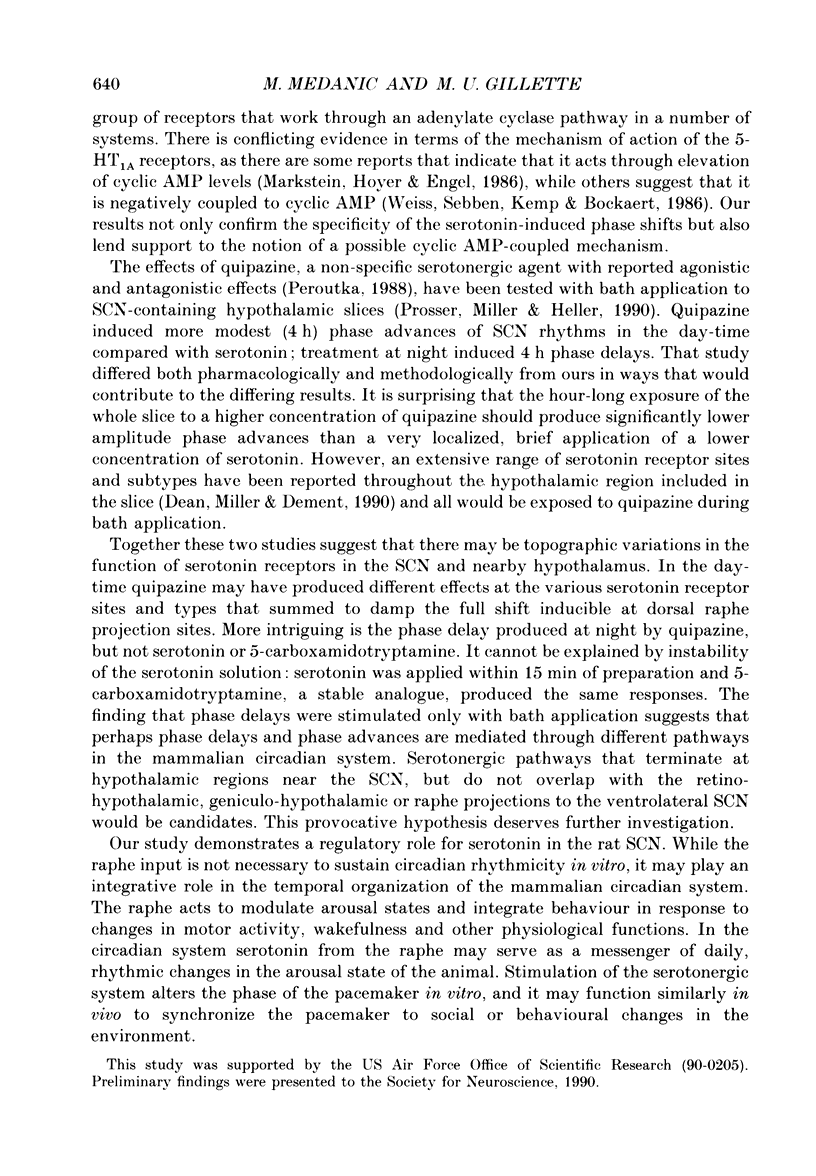
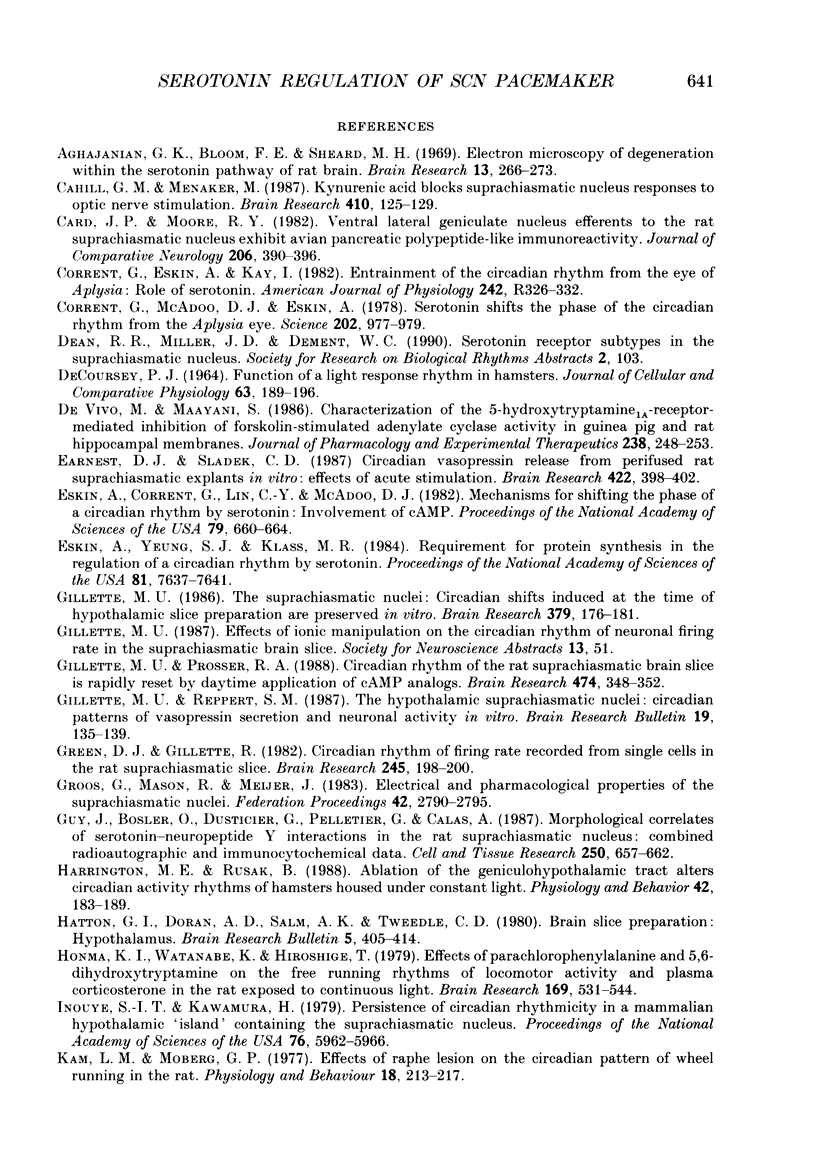
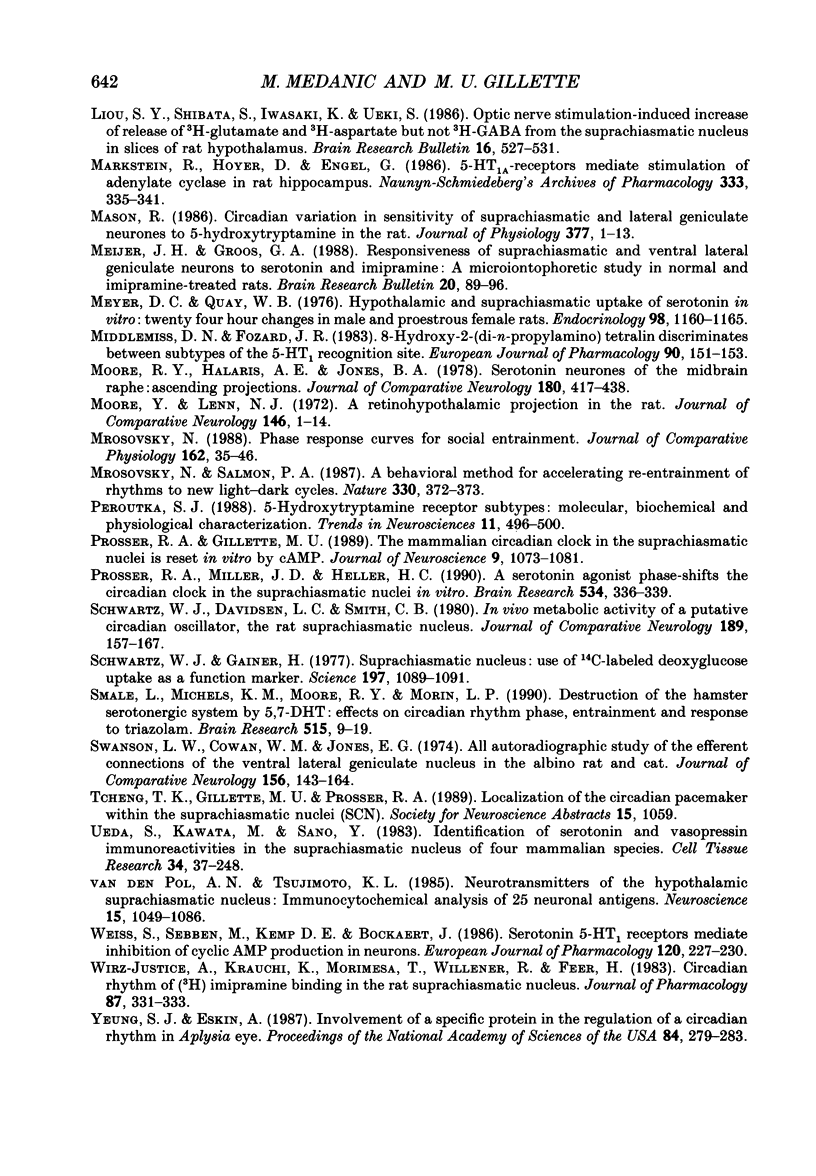
Selected References
These references are in PubMed. This may not be the complete list of references from this article.
- Aghajanian G. K., Bloom F. E., Sheard M. H. Electron microscopy of degeneration within the serotonin pathway of rat brain. Brain Res. 1969 Apr;13(2):266–273. doi: 10.1016/0006-8993(69)90286-8. [DOI] [PubMed] [Google Scholar]
- Cahill G. M., Menaker M. Kynurenic acid blocks suprachiasmatic nucleus responses to optic nerve stimulation. Brain Res. 1987 Apr 28;410(1):125–129. doi: 10.1016/s0006-8993(87)80032-x. [DOI] [PubMed] [Google Scholar]
- Card J. P., Moore R. Y. Ventral lateral geniculate nucleus efferents to the rat suprachiasmatic nucleus exhibit avian pancreatic polypeptide-like immunoreactivity. J Comp Neurol. 1982 Apr 20;206(4):390–396. doi: 10.1002/cne.902060407. [DOI] [PubMed] [Google Scholar]
- Corrent G., Eskin A., Kay I. Entrainment of the circadian rhythm from the eye of Aplysia: role of serotonin. Am J Physiol. 1982 Mar;242(3):R326–R332. doi: 10.1152/ajpregu.1982.242.3.R326. [DOI] [PubMed] [Google Scholar]
- Corrent G., McAdoo D. J., Eskin A. Serotonin shifts the phase of the circadian rhythm from the Aplysia eye. Science. 1978 Dec 1;202(4371):977–979. doi: 10.1126/science.309655. [DOI] [PubMed] [Google Scholar]
- DECOURSEY P. J. FUNCTION OF A LIGHT RESPONSE RHYTHM IN HAMSTERS. J Cell Physiol. 1964 Apr;63:189–196. doi: 10.1002/jcp.1030630208. [DOI] [PubMed] [Google Scholar]
- De Vivo M., Maayani S. Characterization of the 5-hydroxytryptamine1a receptor-mediated inhibition of forskolin-stimulated adenylate cyclase activity in guinea pig and rat hippocampal membranes. J Pharmacol Exp Ther. 1986 Jul;238(1):248–253. [PubMed] [Google Scholar]
- Earnest D. J., Sladek C. D. Circadian vasopressin release from perifused rat suprachiasmatic explants in vitro: effects of acute stimulation. Brain Res. 1987 Oct 6;422(2):398–402. doi: 10.1016/0006-8993(87)90952-8. [DOI] [PubMed] [Google Scholar]
- Eskin A., Corrent G., Lin C. Y., McAdoo D. J. Mechanism for shifting the phase of a circadian rhythm by serotonin: involvement of cAMP. Proc Natl Acad Sci U S A. 1982 Jan;79(2):660–664. doi: 10.1073/pnas.79.2.660. [DOI] [PMC free article] [PubMed] [Google Scholar]
- Eskin A., Yeung S. J., Klass M. R. Requirement for protein synthesis in the regulation of a circadian rhythm by serotonin. Proc Natl Acad Sci U S A. 1984 Dec;81(23):7637–7641. doi: 10.1073/pnas.81.23.7637. [DOI] [PMC free article] [PubMed] [Google Scholar]
- Gillette M. U., Prosser R. A. Circadian rhythm of the rat suprachiasmatic brain slice is rapidly reset by daytime application of cAMP analogs. Brain Res. 1988 Dec 6;474(2):348–352. doi: 10.1016/0006-8993(88)90449-0. [DOI] [PubMed] [Google Scholar]
- Gillette M. U., Reppert S. M. The hypothalamic suprachiasmatic nuclei: circadian patterns of vasopressin secretion and neuronal activity in vitro. Brain Res Bull. 1987 Jul;19(1):135–139. doi: 10.1016/0361-9230(87)90176-6. [DOI] [PubMed] [Google Scholar]
- Gillette M. U. The suprachiasmatic nuclei: circadian phase-shifts induced at the time of hypothalamic slice preparation are preserved in vitro. Brain Res. 1986 Jul 30;379(1):176–181. doi: 10.1016/0006-8993(86)90273-8. [DOI] [PubMed] [Google Scholar]
- Green D. J., Gillette R. Circadian rhythm of firing rate recorded from single cells in the rat suprachiasmatic brain slice. Brain Res. 1982 Aug 5;245(1):198–200. doi: 10.1016/0006-8993(82)90361-4. [DOI] [PubMed] [Google Scholar]
- Groos G., Mason R., Meijer J. Electrical and pharmacological properties of the suprachiasmatic nuclei. Fed Proc. 1983 Aug;42(11):2790–2795. [PubMed] [Google Scholar]
- Guy J., Bosler O., Dusticier G., Pelletier G., Calas A. Morphological correlates of serotonin-neuropeptide Y interactions in the rat suprachiasmatic nucleus: combined radioautographic and immunocytochemical data. Cell Tissue Res. 1987 Dec;250(3):657–662. doi: 10.1007/BF00218960. [DOI] [PubMed] [Google Scholar]
- Harrington M. E., Rusak B. Ablation of the geniculo-hypothalamic tract alters circadian activity rhythms of hamsters housed under constant light. Physiol Behav. 1988;42(2):183–189. doi: 10.1016/0031-9384(88)90296-x. [DOI] [PubMed] [Google Scholar]
- Hatton G. I., Doran A. D., Salm A. K., Tweedle C. D. Brain slice preparation: hypothalamus. Brain Res Bull. 1980 Jul-Aug;5(4):405–414. doi: 10.1016/s0361-9230(80)80010-4. [DOI] [PubMed] [Google Scholar]
- Honma K. I., Watanabe K., Hiroshige T. Effects of parachlorophenylalanine and 5, 6-dihydroxytryptamine on the free-running rhythms of locomotor activity and plasma corticosterone in the rat exposed to continuous light. Brain Res. 1979 Jun 29;169(3):531–544. doi: 10.1016/0006-8993(79)90402-5. [DOI] [PubMed] [Google Scholar]
- Inouye S. T., Kawamura H. Persistence of circadian rhythmicity in a mammalian hypothalamic "island" containing the suprachiasmatic nucleus. Proc Natl Acad Sci U S A. 1979 Nov;76(11):5962–5966. doi: 10.1073/pnas.76.11.5962. [DOI] [PMC free article] [PubMed] [Google Scholar]
- Kam L. M., Moberg G. P. Effect of raphe lesions on the circadian pattern of wheel running in the rat. Physiol Behav. 1977 Feb;18(2):213–217. doi: 10.1016/0031-9384(77)90124-x. [DOI] [PubMed] [Google Scholar]
- Liou S. Y., Shibata S., Iwasaki K., Ueki S. Optic nerve stimulation-induced increase of release of 3H-glutamate and 3H-aspartate but not 3H-GABA from the suprachiasmatic nucleus in slices of rat hypothalamus. Brain Res Bull. 1986 Apr;16(4):527–531. doi: 10.1016/0361-9230(86)90182-6. [DOI] [PubMed] [Google Scholar]
- Markstein R., Hoyer D., Engel G. 5-HT1A-receptors mediate stimulation of adenylate cyclase in rat hippocampus. Naunyn Schmiedebergs Arch Pharmacol. 1986 Aug;333(4):335–341. doi: 10.1007/BF00500006. [DOI] [PubMed] [Google Scholar]
- Mason R. Circadian variation in sensitivity of suprachiasmatic and lateral geniculate neurones to 5-hydroxytryptamine in the rat. J Physiol. 1986 Aug;377:1–13. doi: 10.1113/jphysiol.1986.sp016172. [DOI] [PMC free article] [PubMed] [Google Scholar]
- Meijer J. H., Groos G. A. Responsiveness of suprachiasmatic and ventral lateral geniculate neurons to serotonin and imipramine: a microiontophoretic study in normal and imipramine-treated rats. Brain Res Bull. 1988 Jan;20(1):89–96. doi: 10.1016/0361-9230(88)90012-3. [DOI] [PubMed] [Google Scholar]
- Meyer D. C., Quay W. B. Hypothalamic and suprachiasmatic uptake of serotonin in vitro: twenty-four-hour changes in male and proestrous female rats. Endocrinology. 1976 May;98(5):1160–1165. doi: 10.1210/endo-98-5-1160. [DOI] [PubMed] [Google Scholar]
- Middlemiss D. N., Fozard J. R. 8-Hydroxy-2-(di-n-propylamino)-tetralin discriminates between subtypes of the 5-HT1 recognition site. Eur J Pharmacol. 1983 May 20;90(1):151–153. doi: 10.1016/0014-2999(83)90230-3. [DOI] [PubMed] [Google Scholar]
- Moore R. Y., Halaris A. E., Jones B. E. Serotonin neurons of the midbrain raphe: ascending projections. J Comp Neurol. 1978 Aug 1;180(3):417–438. doi: 10.1002/cne.901800302. [DOI] [PubMed] [Google Scholar]
- Moore R. Y., Lenn N. J. A retinohypothalamic projection in the rat. J Comp Neurol. 1972 Sep;146(1):1–14. doi: 10.1002/cne.901460102. [DOI] [PubMed] [Google Scholar]
- Mrosovsky N. Phase response curves for social entrainment. J Comp Physiol A. 1988 Jan;162(1):35–46. doi: 10.1007/BF01342701. [DOI] [PubMed] [Google Scholar]
- Mrosovsky N., Salmon P. A. A behavioural method for accelerating re-entrainment of rhythms to new light-dark cycles. 1987 Nov 26-Dec 2Nature. 330(6146):372–373. doi: 10.1038/330372a0. [DOI] [PubMed] [Google Scholar]
- Peroutka S. J. 5-Hydroxytryptamine receptor subtypes: molecular, biochemical and physiological characterization. Trends Neurosci. 1988 Nov;11(11):496–500. doi: 10.1016/0166-2236(88)90011-2. [DOI] [PubMed] [Google Scholar]
- Prosser R. A., Gillette M. U. The mammalian circadian clock in the suprachiasmatic nuclei is reset in vitro by cAMP. J Neurosci. 1989 Mar;9(3):1073–1081. doi: 10.1523/JNEUROSCI.09-03-01073.1989. [DOI] [PMC free article] [PubMed] [Google Scholar]
- Prosser R. A., Miller J. D., Heller H. C. A serotonin agonist phase-shifts the circadian clock in the suprachiasmatic nuclei in vitro. Brain Res. 1990 Nov 26;534(1-2):336–339. doi: 10.1016/0006-8993(90)90153-3. [DOI] [PubMed] [Google Scholar]
- Schwartz W. J., Davidsen L. C., Smith C. B. In vivo metabolic activity of a putative circadian oscillator, the rat suprachiasmatic nucleus. J Comp Neurol. 1980 Jan 1;189(1):157–167. doi: 10.1002/cne.901890109. [DOI] [PubMed] [Google Scholar]
- Schwartz W. J., Gainer H. Suprachiasmatic nucleus: use of 14C-labeled deoxyglucose uptake as a functional marker. Science. 1977 Sep 9;197(4308):1089–1091. doi: 10.1126/science.887940. [DOI] [PubMed] [Google Scholar]
- Smale L., Michels K. M., Moore R. Y., Morin L. P. Destruction of the hamster serotonergic system by 5,7-DHT: effects on circadian rhythm phase, entrainment and response to triazolam. Brain Res. 1990 May 7;515(1-2):9–19. doi: 10.1016/0006-8993(90)90570-2. [DOI] [PubMed] [Google Scholar]
- Swanson L. W., Cowan W. M., Jones E. G. An autoradiographic study of the efferent connections of the ventral lateral geniculate nucleus in the albino rat and the cat. J Comp Neurol. 1974 Jul;156(2):143–163. doi: 10.1002/cne.901560203. [DOI] [PubMed] [Google Scholar]
- Ueda S., Kawata M., Sano Y. Identification of serotonin- and vasopressin immunoreactivities in the suprachiasmatic nucleus of four mammalian species. Cell Tissue Res. 1983;234(2):237–248. doi: 10.1007/BF00213766. [DOI] [PubMed] [Google Scholar]
- Weiss S., Sebben M., Kemp D. E., Bockaert J. Serotonin 5-HT1 receptors mediate inhibition of cyclic AMP production in neurons. Eur J Pharmacol. 1986 Jan 21;120(2):227–230. doi: 10.1016/0014-2999(86)90544-3. [DOI] [PubMed] [Google Scholar]
- Wirz-Justice A., Kräuchi K., Morimasa T., Willener R., Feer H. Circadian rhythm of [3H]imipramine binding in the rat suprachiasmatic nuclei. Eur J Pharmacol. 1983 Feb 18;87(2-3):331–333. doi: 10.1016/0014-2999(83)90348-5. [DOI] [PubMed] [Google Scholar]
- Yeung S. J., Eskin A. Involvement of a specific protein in the regulation of a circadian rhythm in Aplysia eye. Proc Natl Acad Sci U S A. 1987 Jan;84(1):279–283. doi: 10.1073/pnas.84.1.279. [DOI] [PMC free article] [PubMed] [Google Scholar]
- van den Pol A. N., Tsujimoto K. L. Neurotransmitters of the hypothalamic suprachiasmatic nucleus: immunocytochemical analysis of 25 neuronal antigens. Neuroscience. 1985 Aug;15(4):1049–1086. doi: 10.1016/0306-4522(85)90254-4. [DOI] [PubMed] [Google Scholar]


